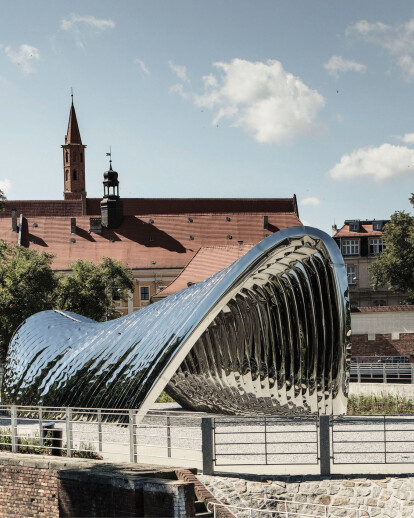This architectural, public sculpture consists of 35 bionic steel arches referring in form to the shape of the island and most of all to construction of nearby historic architecture of Ostrów Tumski originally established in XI century. The arches together create an ultralight, durable construction, its mirror-polished surface reflects the surroundings and gives the effect of a naturally growing sculpture that changes throughout the day and seasons.
NAWA is part of revitalization programme for Daliowa Island – the smallest of over a dozen islands in downtown Wrocław. Aim of the programme was to turn neglected and forgotten space into an area open to meetings, concerts and artistic events, thus a reclamation to city inhabitants. NAWA is the crowning piece of celebrating European Capital of Culture – Wrocław 2016. The inspiration for use of arc construction was inspired by nearby Cathedral of St. John the Baptist, Market Hall, The Ossolineum and its library. The form of bionic arch goes along with shape of the very island and corresponds with surrounding architecture.
Designed shape of the object was divided into individual pieces with original algorithm and in specialist software for parametric design. It allowed to adjust the force arrow and to optimize production, transport and endurance on the basis of real time (FEM Simulation). The sculpture was made with original FiDU technology (free inner pressure forming) which allows to create tailored, ultralight construction elements in sheet metal. Bionic arches were cut out and welded along the edges and then inflated with compressed air. It allows to change flat 2D objects into durable an delight 3D forms.
The use of stainless steel shaped with innovative FiDU technology makes the project very ecologic. Steel is a sustainable material that can be fully recycled. As the forms are shaped with compressed air, they remain empty inside, that’s why production requires less material and energy comparing to other technologies. Precisely planned production process minimizes the amount of waste that’s is further recycylable. That makes the project fullfill the ideology of circular economy. Slightly wavy surface of mirror-polished stainless steel resembles surface of the water which reflects everything around and changes throughout the day and seasons.
NAWA is the first object made with FiDU technology for such an immense scale and also its manifesto. The initially controversial project became a popular spot for meetings, photo shots and artistic events.
Fun facts:
1- To pomp the elements we needed around 1 000 000 m3 of air.
2- Production process took about 700 hours of work.
3- Combined length of weld totals 2 kilometers.
4- Because of location and size of sculpture, individual arches were executed in old dockyard, north-east of the city, and delivered riverine on barges directly to Daliowa Island.
5- Elements of the sculpture were carried on 3 barges.
6- In all, barges covered the distance of 85 kilometers.
7- The height of the highest profile amounts to 7,5 meters.
8- NAWA covers the area of 100m2.

































